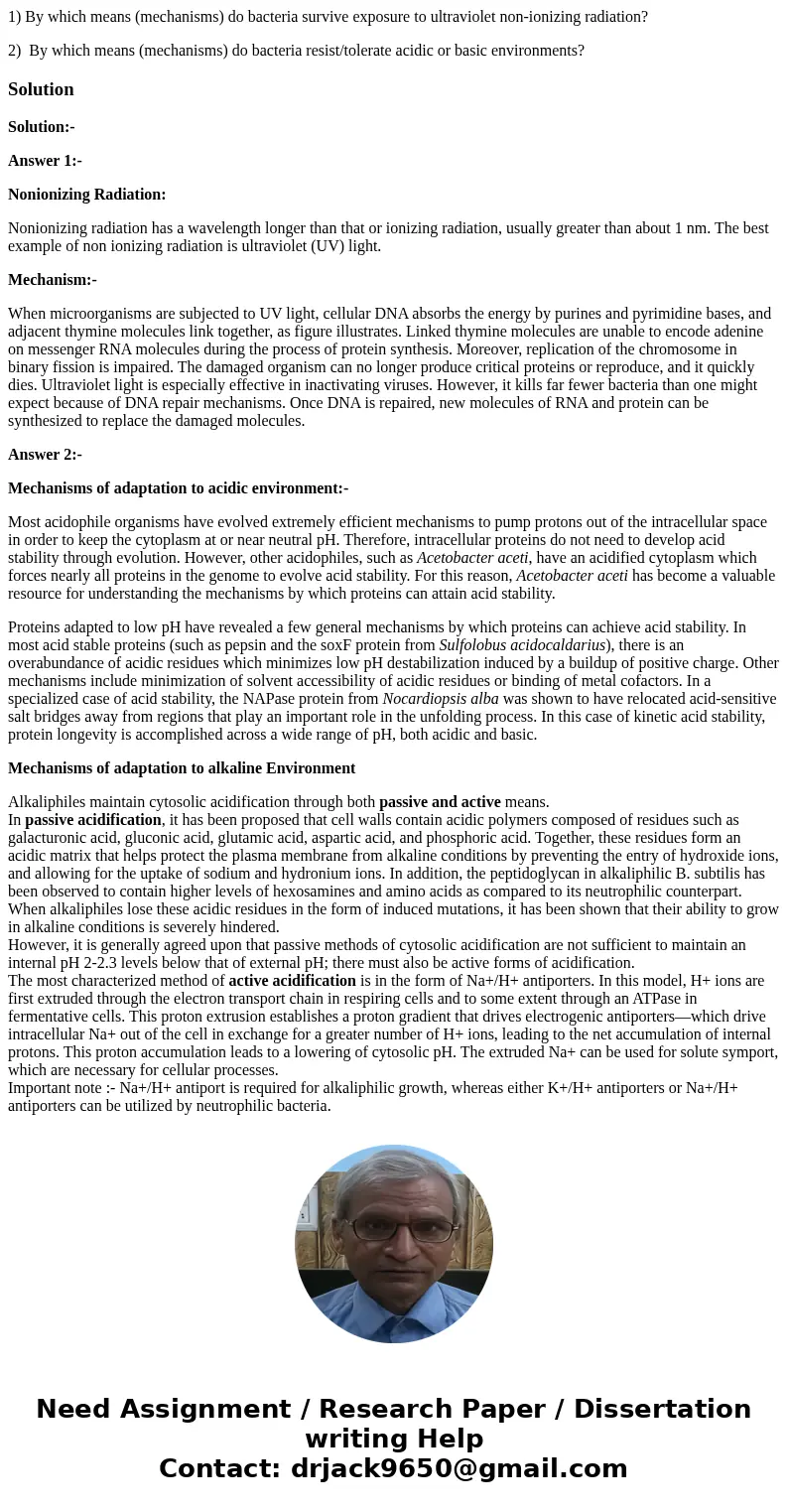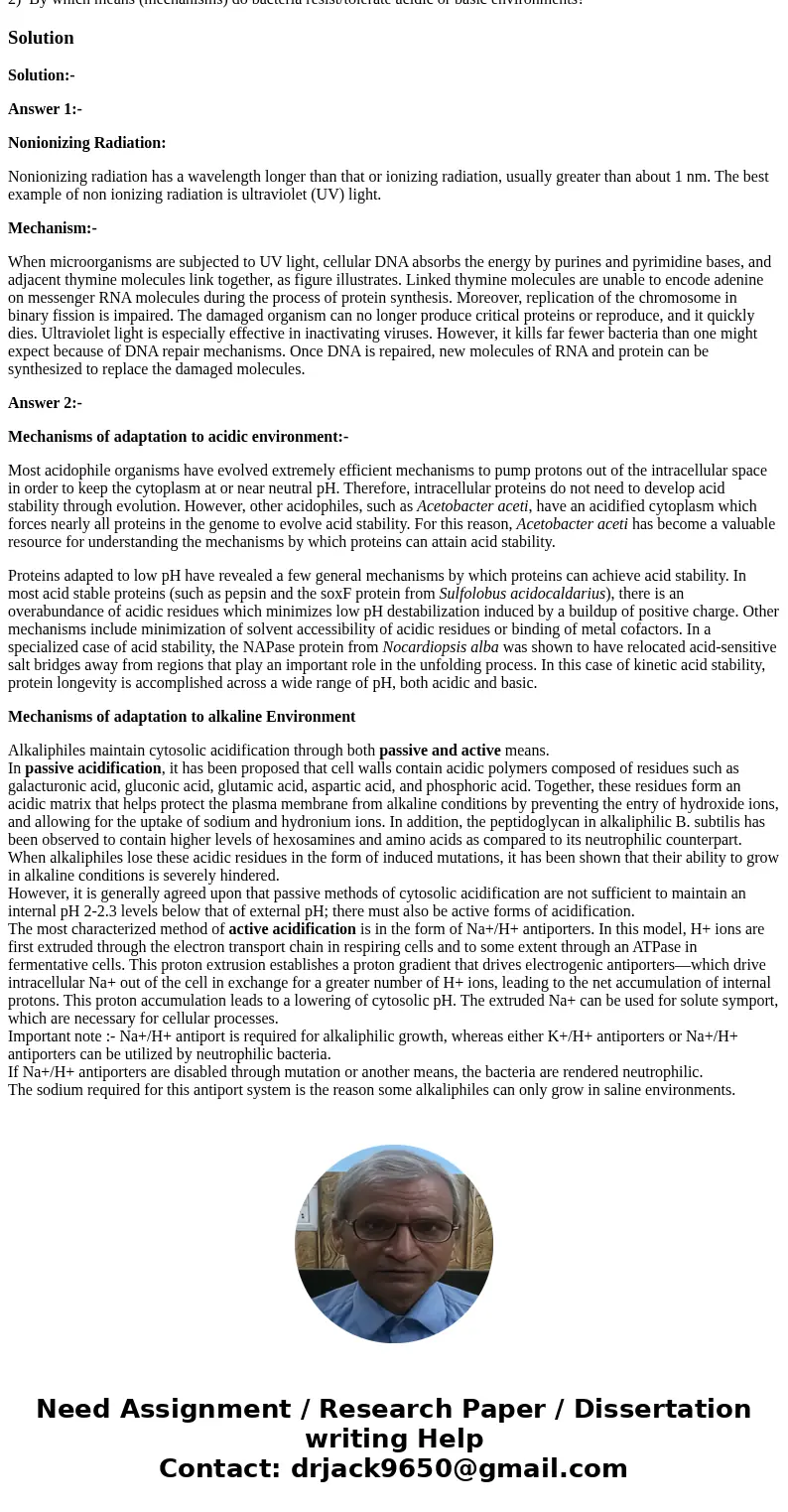1 By which means mechanisms do bacteria survive exposure to
1) By which means (mechanisms) do bacteria survive exposure to ultraviolet non-ionizing radiation?
2) By which means (mechanisms) do bacteria resist/tolerate acidic or basic environments?
Solution
Solution:-
Answer 1:-
Nonionizing Radiation:
Nonionizing radiation has a wavelength longer than that or ionizing radiation, usually greater than about 1 nm. The best example of non ionizing radiation is ultraviolet (UV) light.
Mechanism:-
When microorganisms are subjected to UV light, cellular DNA absorbs the energy by purines and pyrimidine bases, and adjacent thymine molecules link together, as figure illustrates. Linked thymine molecules are unable to encode adenine on messenger RNA molecules during the process of protein synthesis. Moreover, replication of the chromosome in binary fission is impaired. The damaged organism can no longer produce critical proteins or reproduce, and it quickly dies. Ultraviolet light is especially effective in inactivating viruses. However, it kills far fewer bacteria than one might expect because of DNA repair mechanisms. Once DNA is repaired, new molecules of RNA and protein can be synthesized to replace the damaged molecules.
Answer 2:-
Mechanisms of adaptation to acidic environment:-
Most acidophile organisms have evolved extremely efficient mechanisms to pump protons out of the intracellular space in order to keep the cytoplasm at or near neutral pH. Therefore, intracellular proteins do not need to develop acid stability through evolution. However, other acidophiles, such as Acetobacter aceti, have an acidified cytoplasm which forces nearly all proteins in the genome to evolve acid stability. For this reason, Acetobacter aceti has become a valuable resource for understanding the mechanisms by which proteins can attain acid stability.
Proteins adapted to low pH have revealed a few general mechanisms by which proteins can achieve acid stability. In most acid stable proteins (such as pepsin and the soxF protein from Sulfolobus acidocaldarius), there is an overabundance of acidic residues which minimizes low pH destabilization induced by a buildup of positive charge. Other mechanisms include minimization of solvent accessibility of acidic residues or binding of metal cofactors. In a specialized case of acid stability, the NAPase protein from Nocardiopsis alba was shown to have relocated acid-sensitive salt bridges away from regions that play an important role in the unfolding process. In this case of kinetic acid stability, protein longevity is accomplished across a wide range of pH, both acidic and basic.
Mechanisms of adaptation to alkaline Environment
Alkaliphiles maintain cytosolic acidification through both passive and active means.
In passive acidification, it has been proposed that cell walls contain acidic polymers composed of residues such as galacturonic acid, gluconic acid, glutamic acid, aspartic acid, and phosphoric acid. Together, these residues form an acidic matrix that helps protect the plasma membrane from alkaline conditions by preventing the entry of hydroxide ions, and allowing for the uptake of sodium and hydronium ions. In addition, the peptidoglycan in alkaliphilic B. subtilis has been observed to contain higher levels of hexosamines and amino acids as compared to its neutrophilic counterpart. When alkaliphiles lose these acidic residues in the form of induced mutations, it has been shown that their ability to grow in alkaline conditions is severely hindered.
However, it is generally agreed upon that passive methods of cytosolic acidification are not sufficient to maintain an internal pH 2-2.3 levels below that of external pH; there must also be active forms of acidification.
The most characterized method of active acidification is in the form of Na+/H+ antiporters. In this model, H+ ions are first extruded through the electron transport chain in respiring cells and to some extent through an ATPase in fermentative cells. This proton extrusion establishes a proton gradient that drives electrogenic antiporters—which drive intracellular Na+ out of the cell in exchange for a greater number of H+ ions, leading to the net accumulation of internal protons. This proton accumulation leads to a lowering of cytosolic pH. The extruded Na+ can be used for solute symport, which are necessary for cellular processes.
Important note :- Na+/H+ antiport is required for alkaliphilic growth, whereas either K+/H+ antiporters or Na+/H+ antiporters can be utilized by neutrophilic bacteria.
If Na+/H+ antiporters are disabled through mutation or another means, the bacteria are rendered neutrophilic.
The sodium required for this antiport system is the reason some alkaliphiles can only grow in saline environments.


 Homework Sourse
Homework Sourse